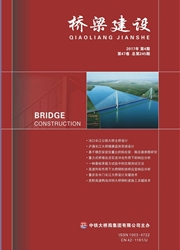

 中文摘要:
中文摘要:
为了解纵向约束体系对铁路悬索桥在列车制动力作用下的动力响应的影响,以某设计中的三跨铁路悬索桥为背景,给出制动力的时程曲线和加载模式,采用有限元软件ANSYS建立全桥模型,计算3种纵向约束体系(塔梁纵向固定约束体系、半飘浮体系及阻尼体系)在列车制动力作用下的动力响应,并对阻尼体系进行参数分析。结果表明:列车制动力作用下,半飘浮体系的梁端位移和梁端速度远远大于纵向固定约束体系和阻尼体系;3种纵向约束体系下,塔顶纵向位移差异不大;半飘浮体系的塔底内力在3种体系中最小,纵向固定约束体系的塔底内力最大;在铁路悬索桥中,纵向约束体系采用阻尼体系更合理。
 英文摘要:
英文摘要:
To have an understanding of the influences of the longitudinal constraint systems on the dynamic responses of railway suspension bridge under the action of train braking force, a threespan railway suspension bridge being designed was cited as an example and the time-history curves and loading modes of the braking force were given. The finite element software ANSYS was used to set up the model for the whole bridge of the suspension bridge, the dynamic responses of 3 types of the longitudinal constraint systems (i. e. the longitudinal fixity constraint system of the towers and stiffening girder, the semi-floating system and the damping system) under the action of the train braking force were calculated and the parametric analysis of the damping system was particu- larly carried out. The results show that under the action of the train braking force, the stiffening girder end displacement and the girder end speed of the semi-floating system are far greater than those of the longitudinal fixity constraint system and the damping system. For the 3 types of the longitudinal constraint systems, the differences of the tower top longitudinal displacement are not great, the tower footing internal force of the semi-floating system is the least among the longitudi- nal constraint systems and the tower footing internal force of the longitudinal fixity constraint sys- tem is the greatest. In the railway suspension bridge, the applying of the damping system is more reasonable.
 同期刊论文项目
同期刊论文项目
 同项目期刊论文
同项目期刊论文
 期刊信息
期刊信息
